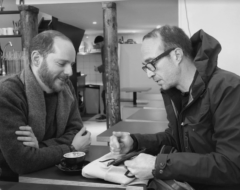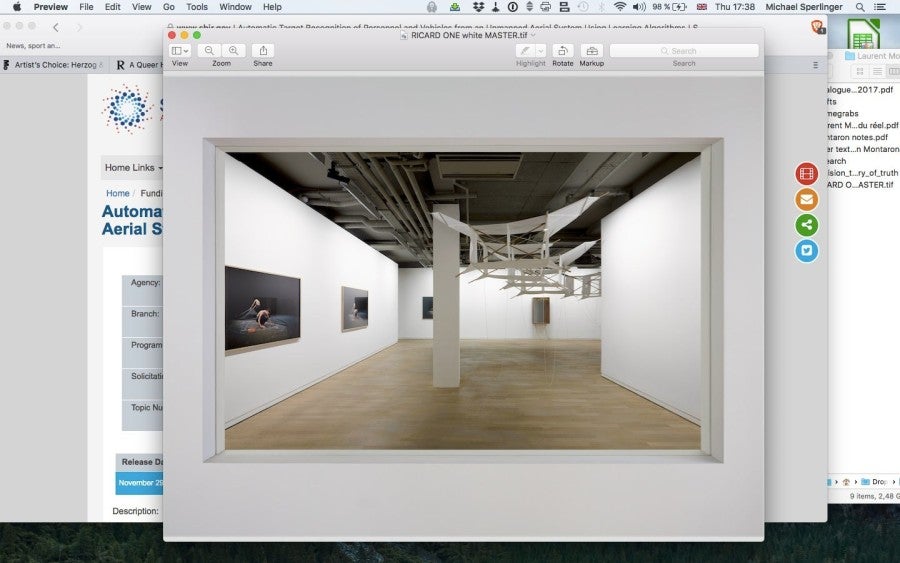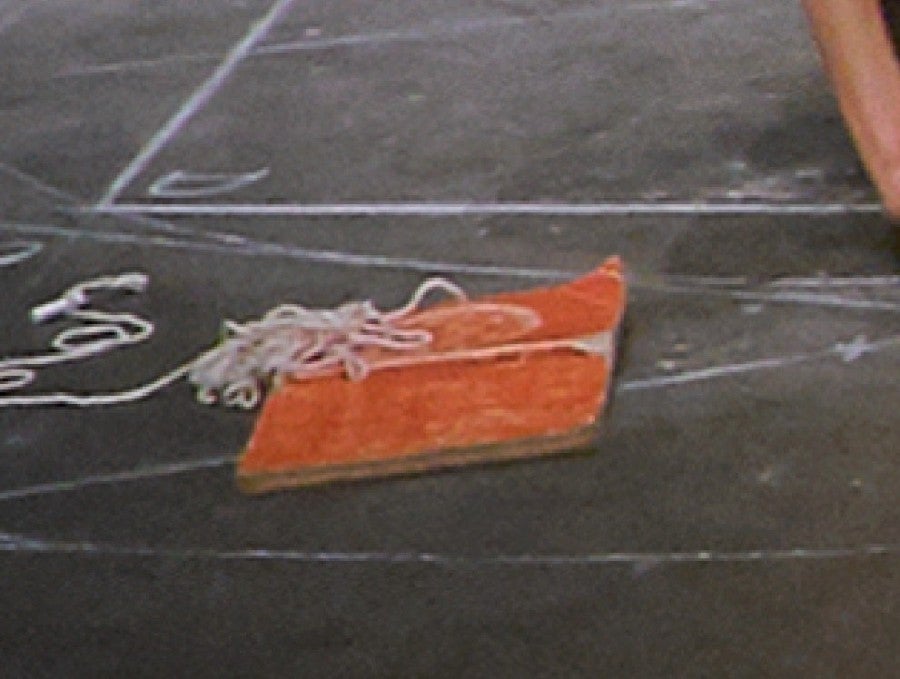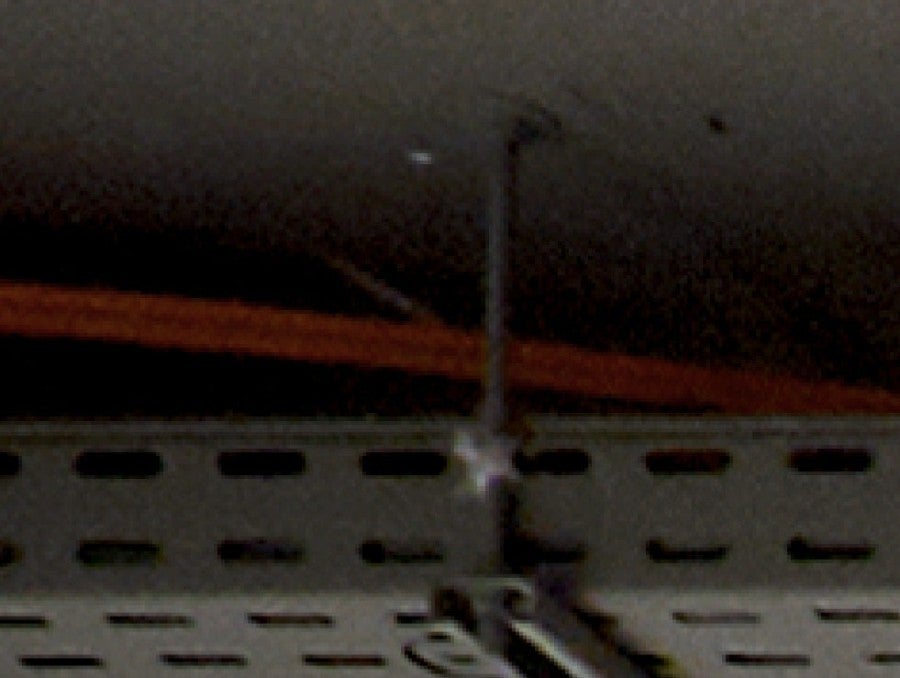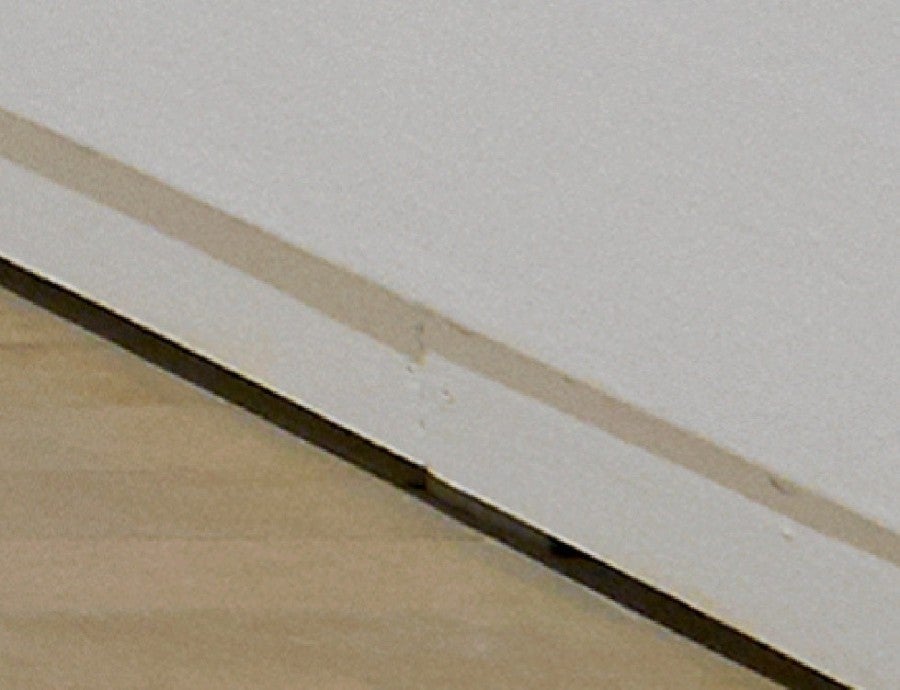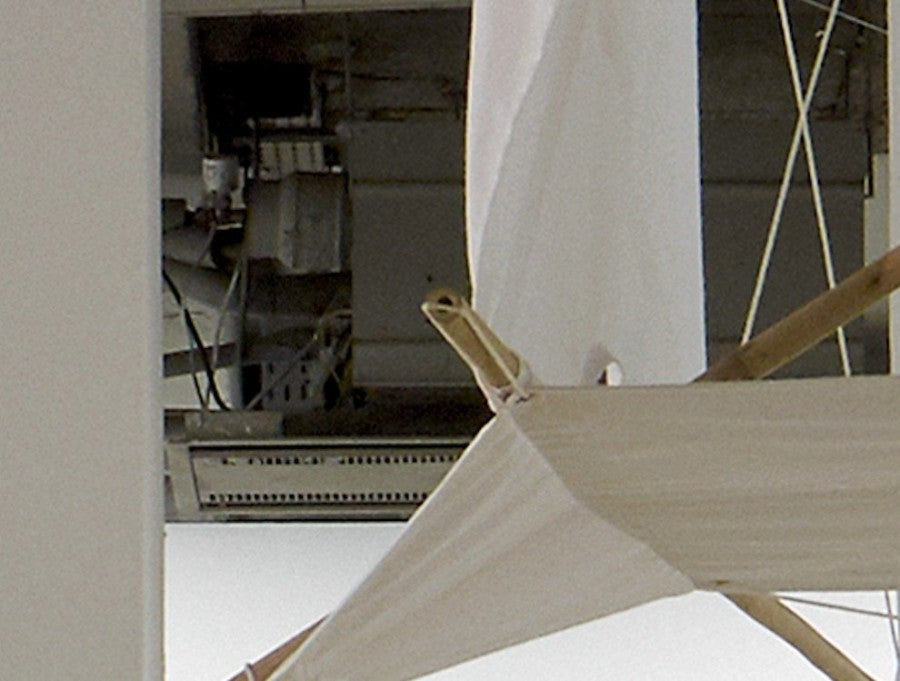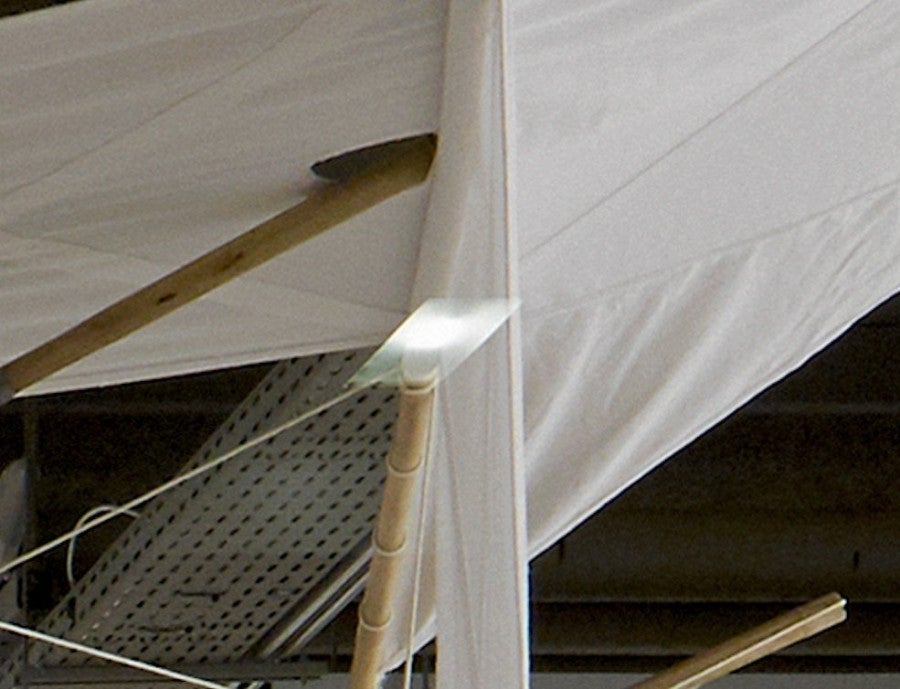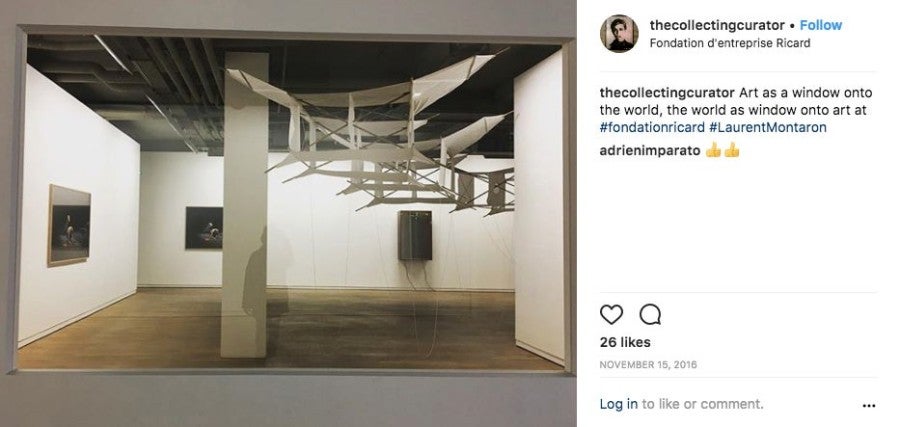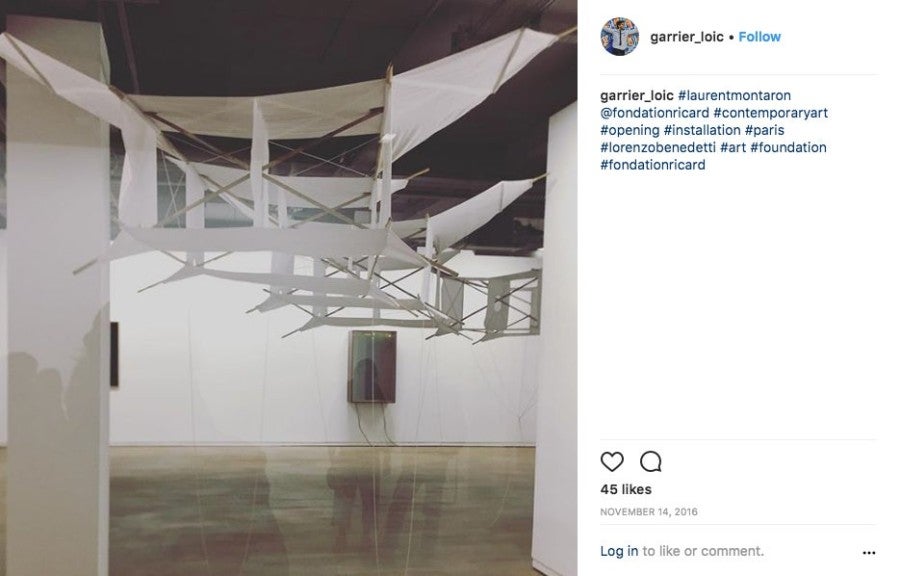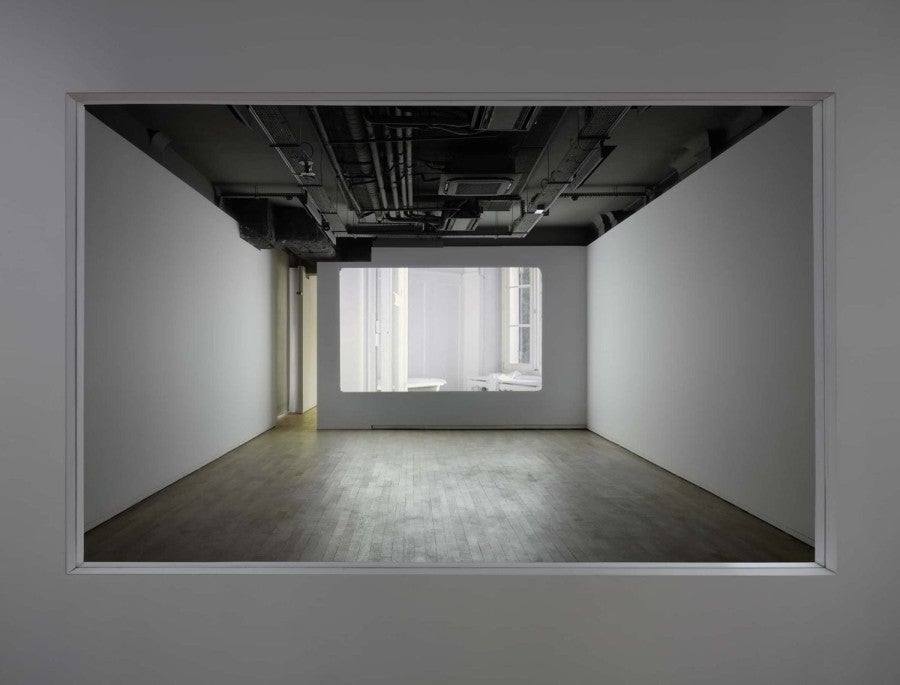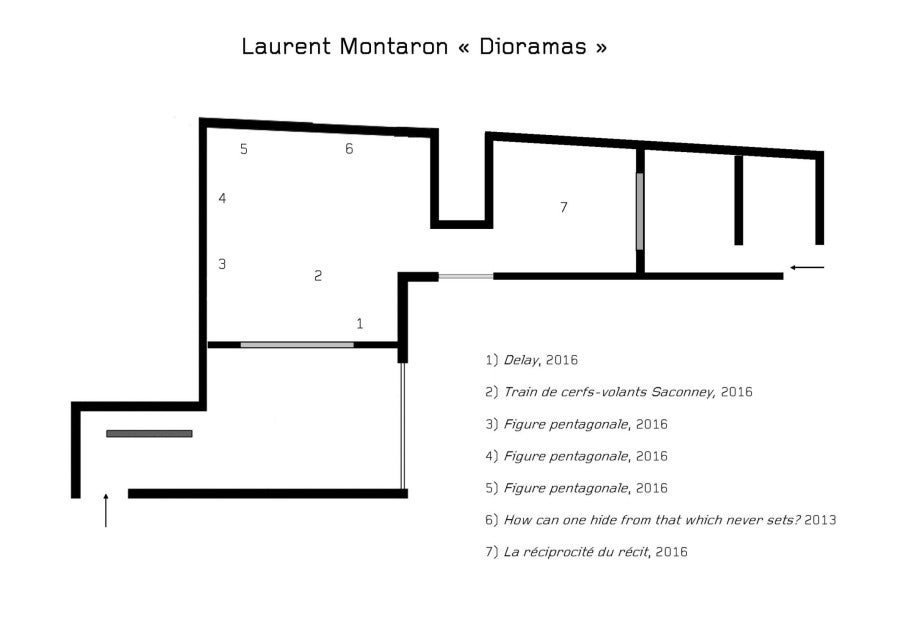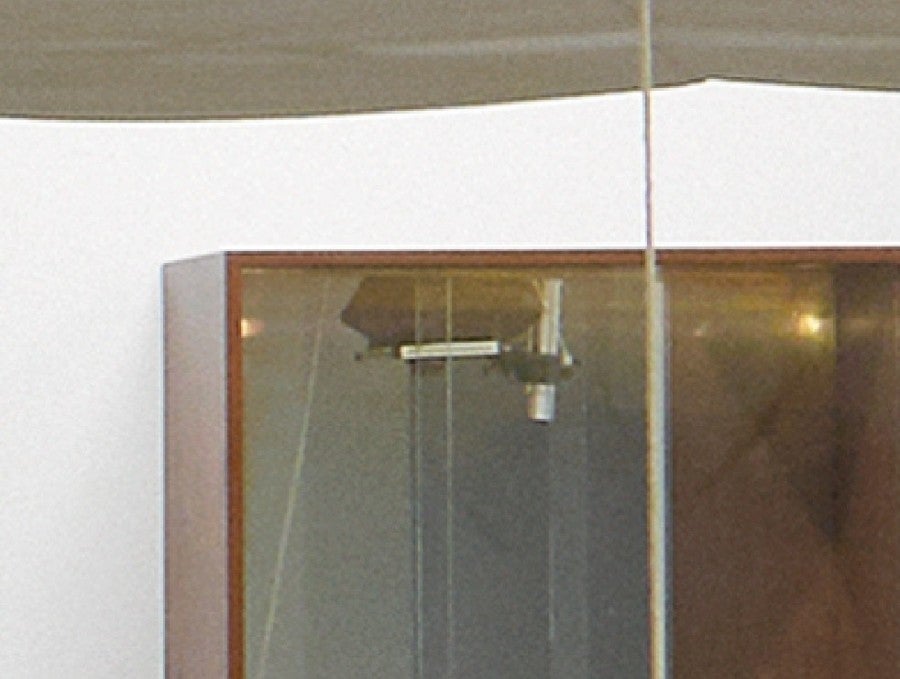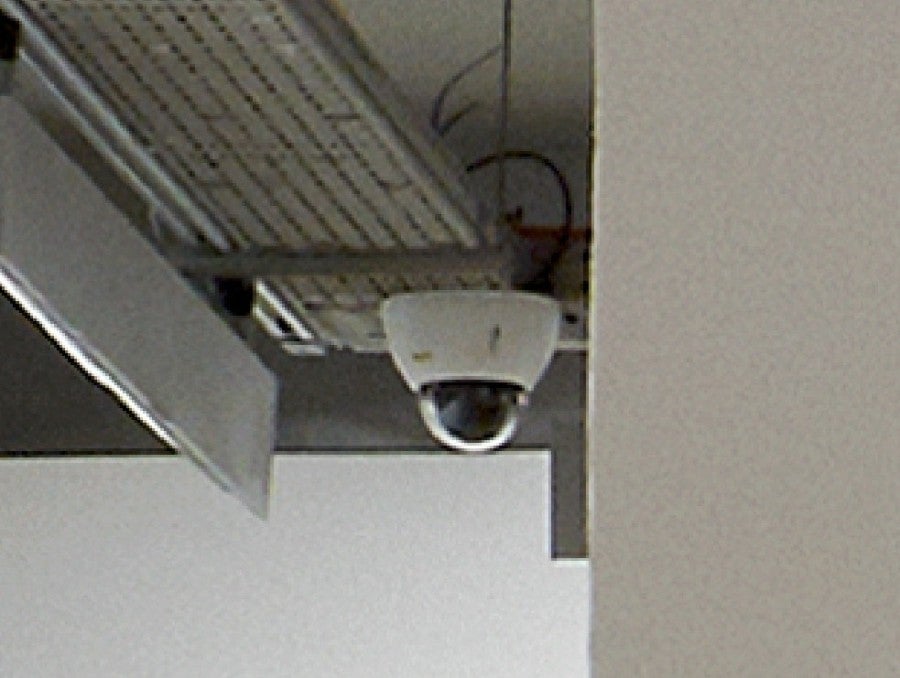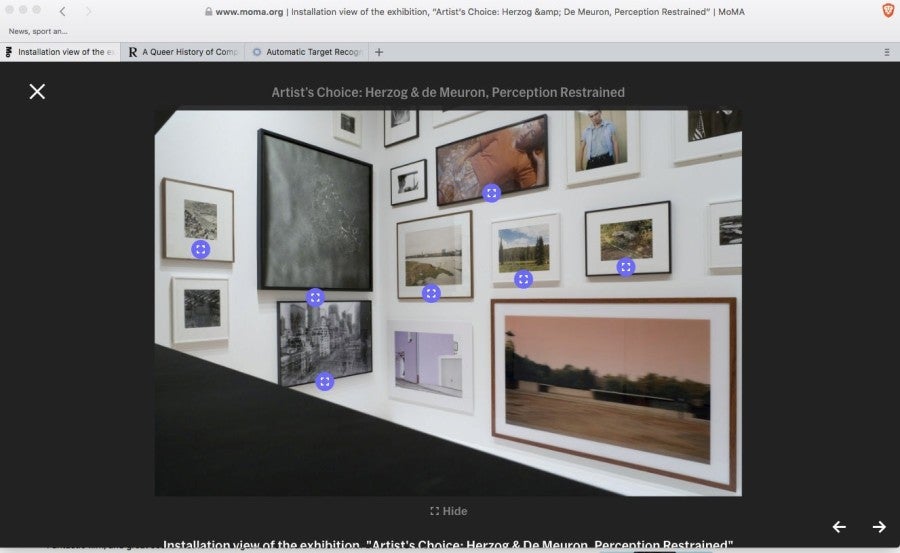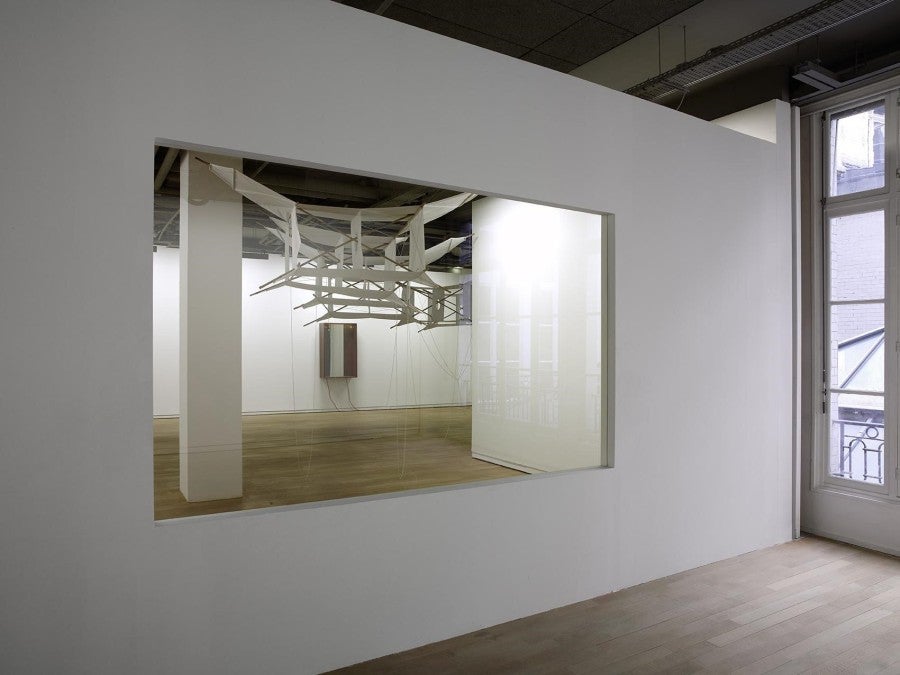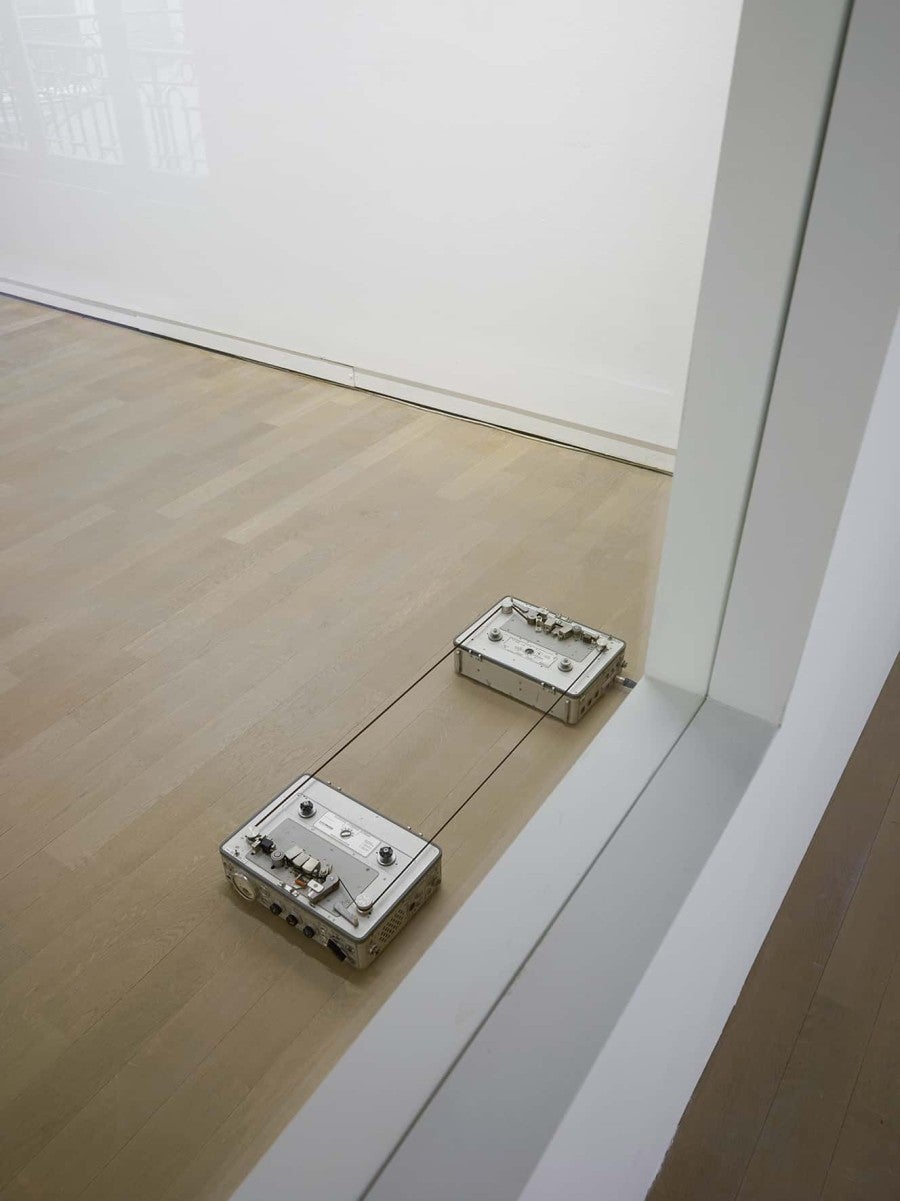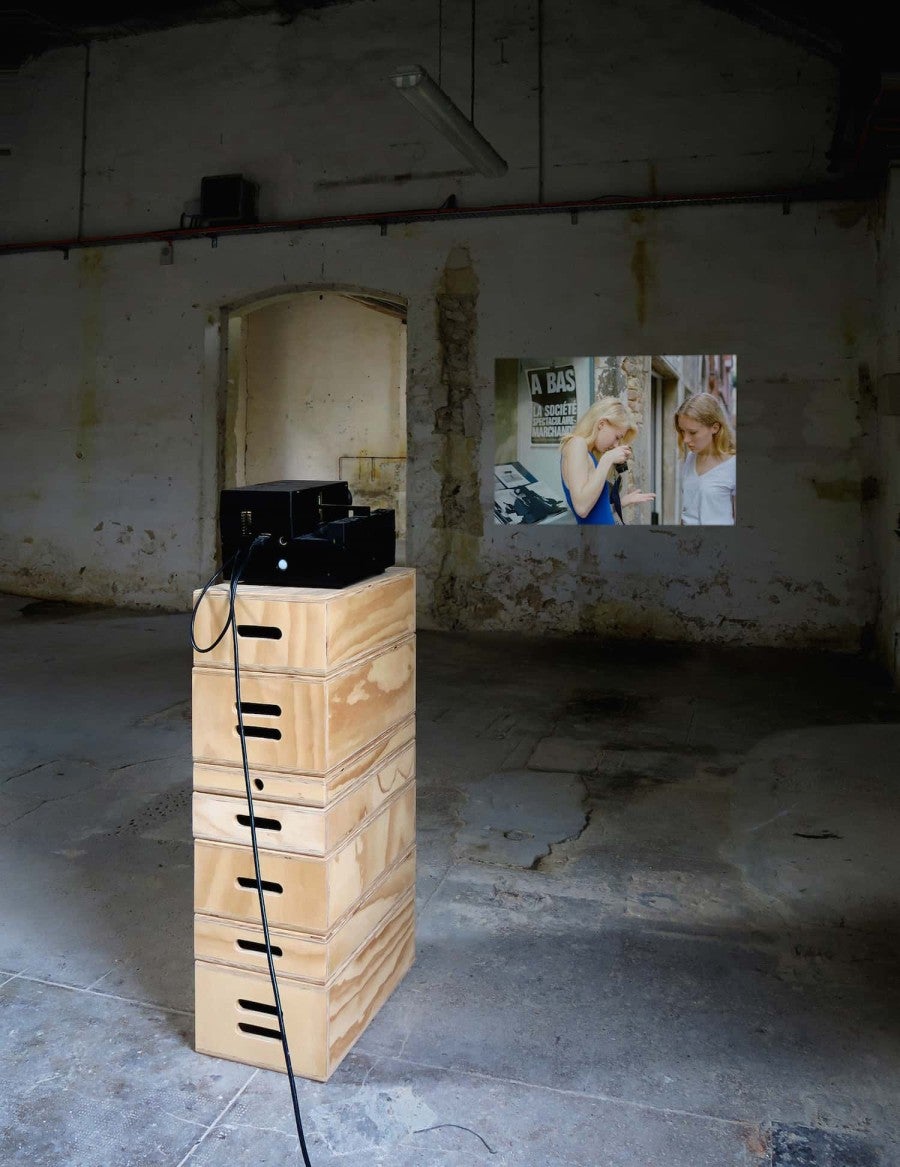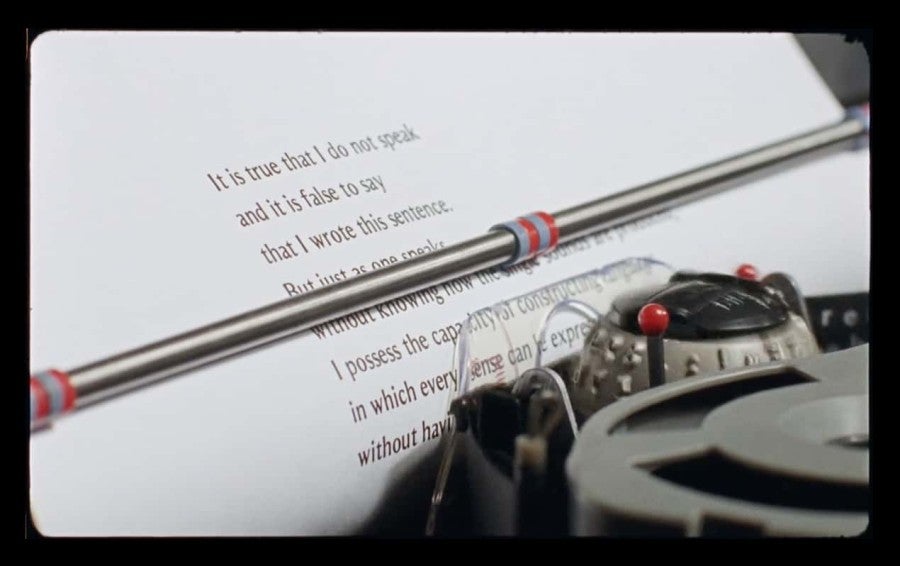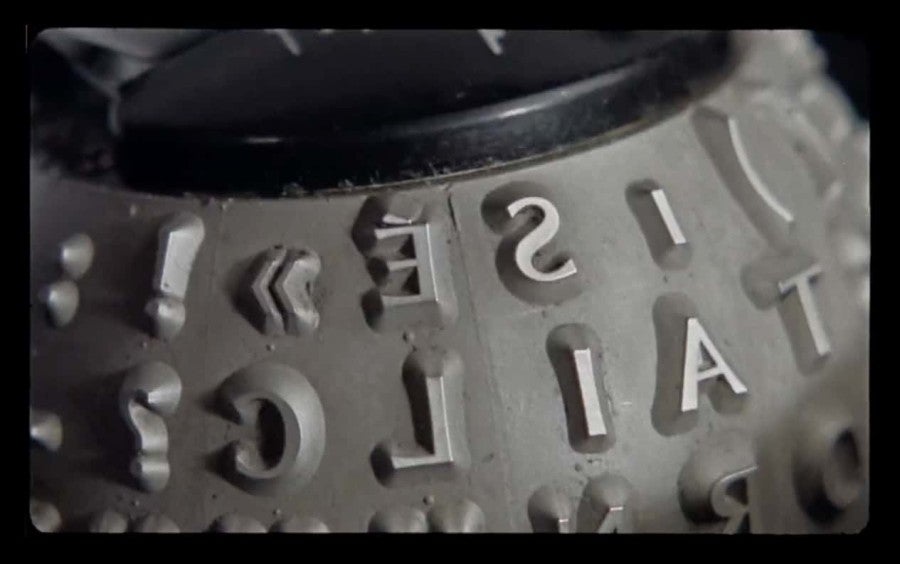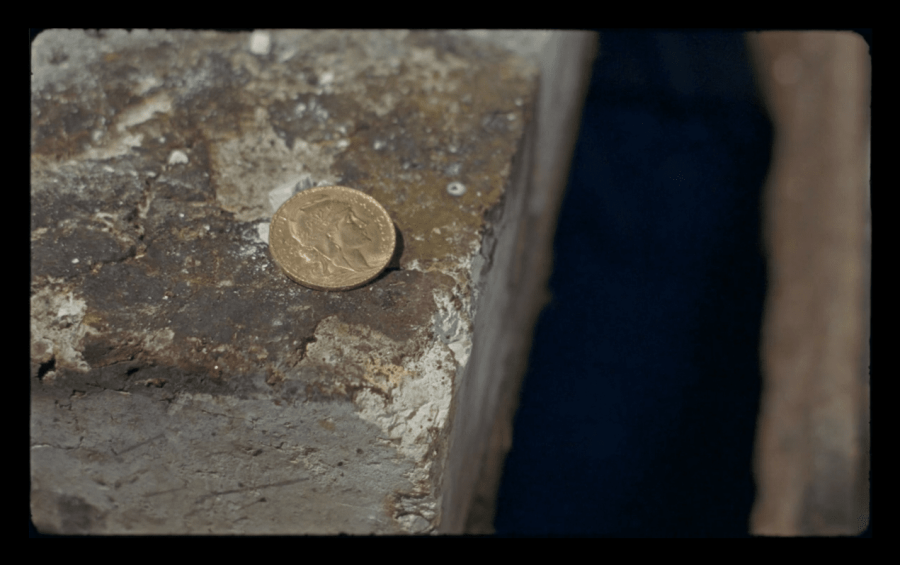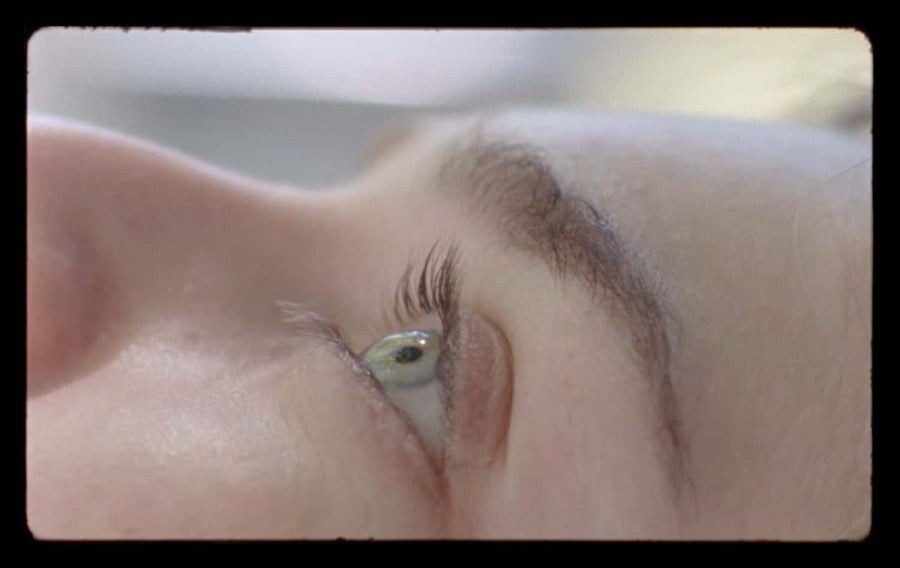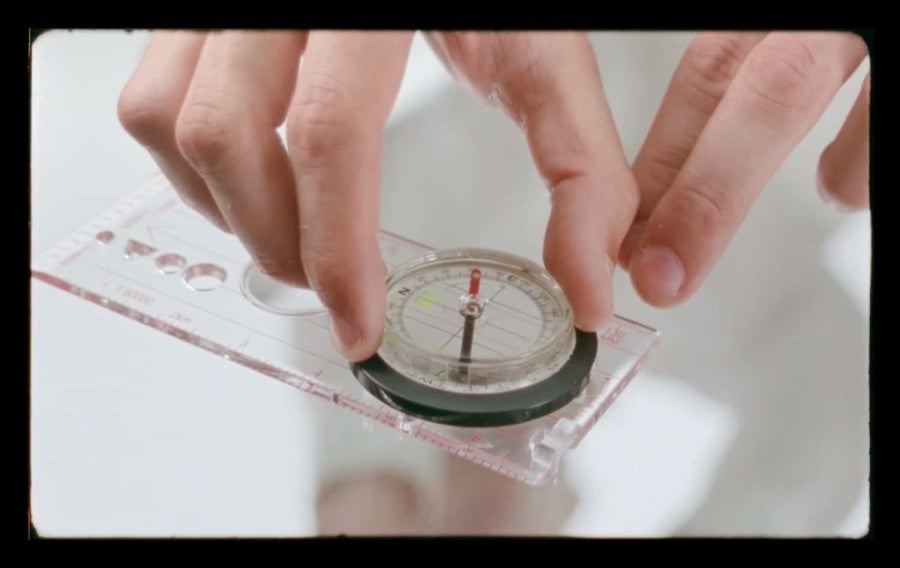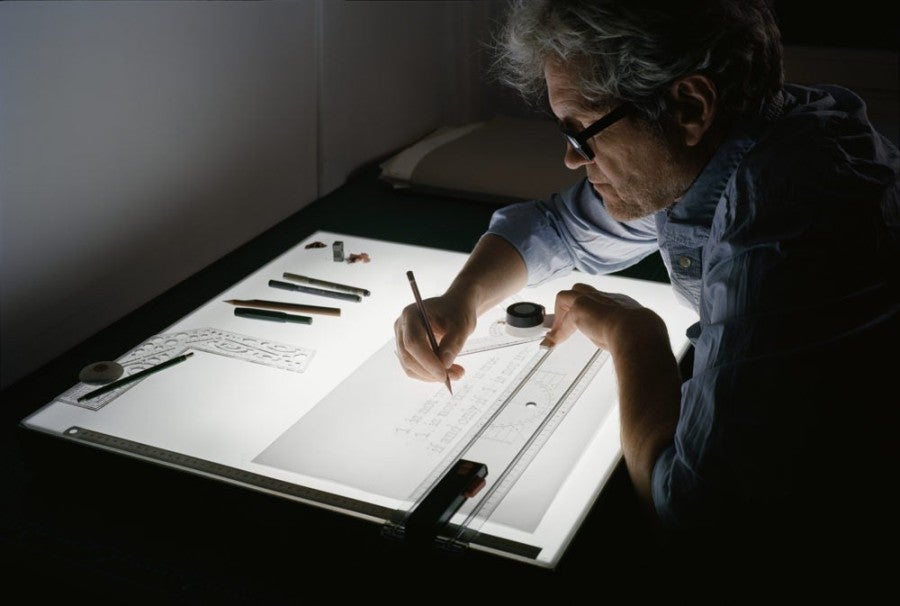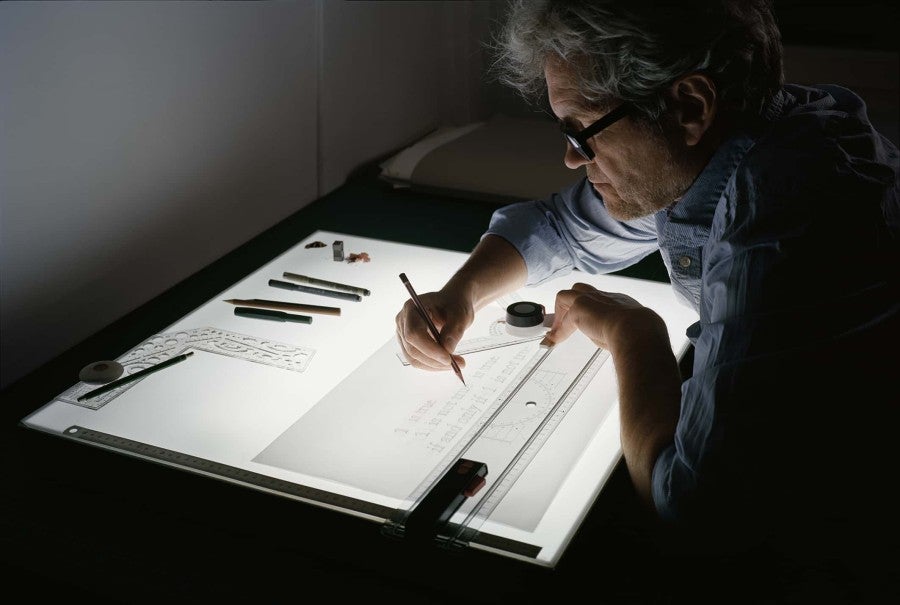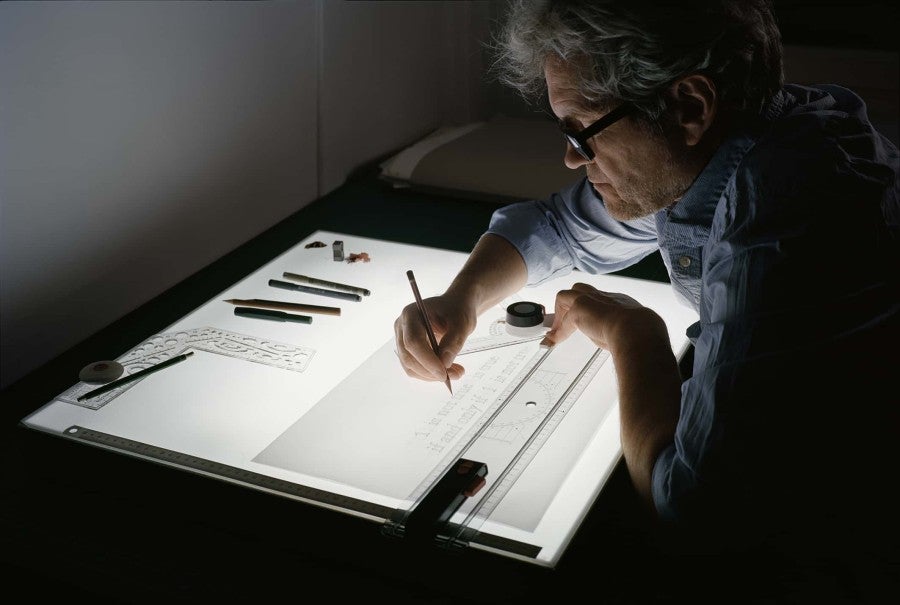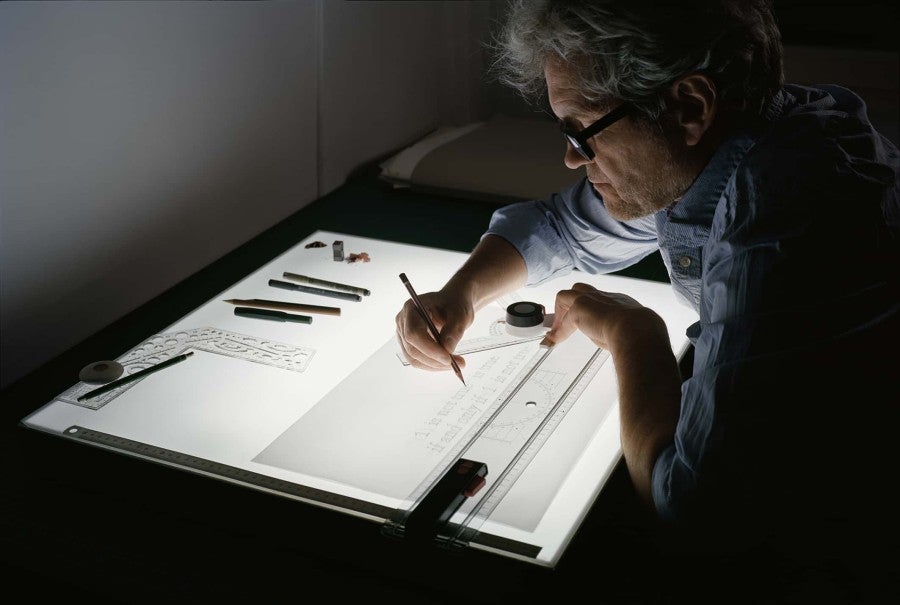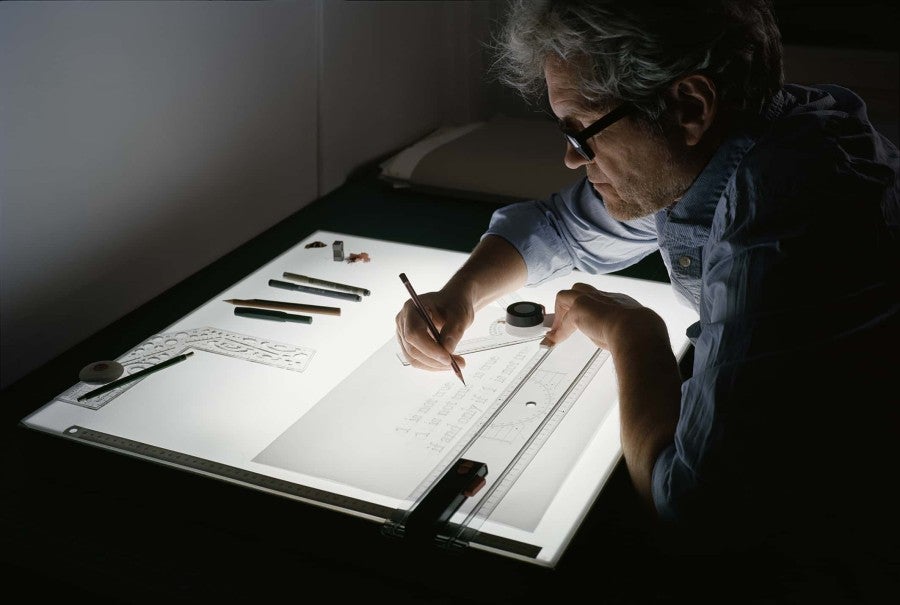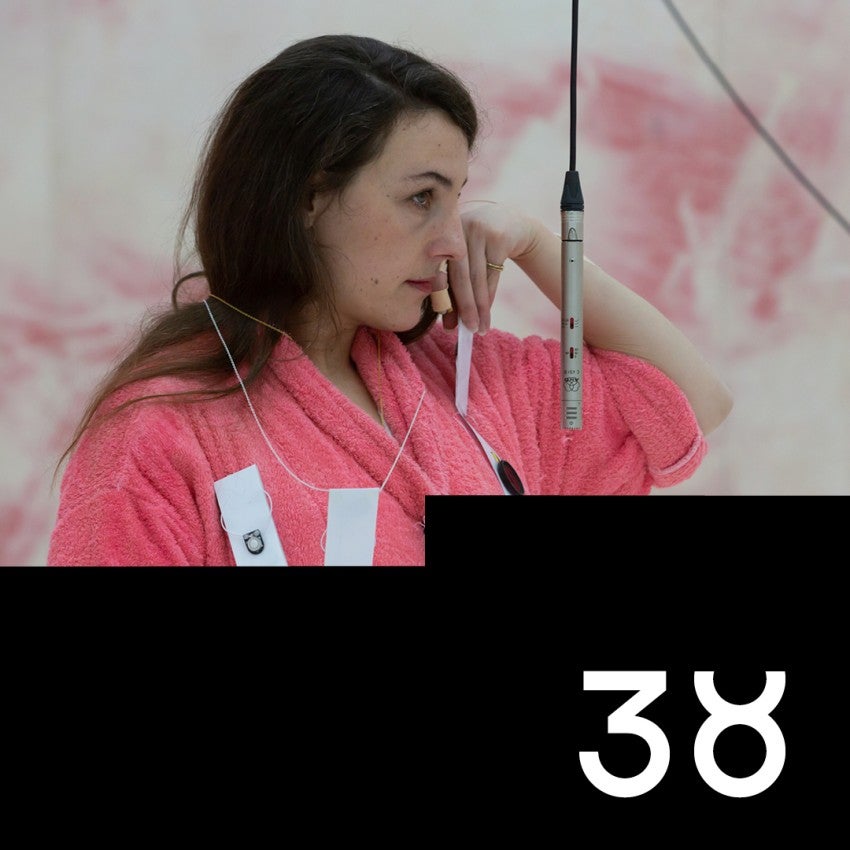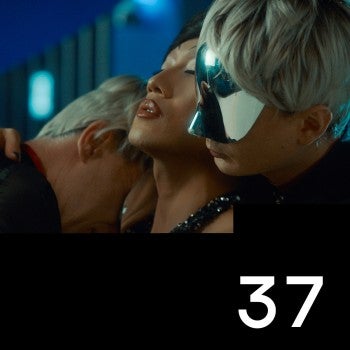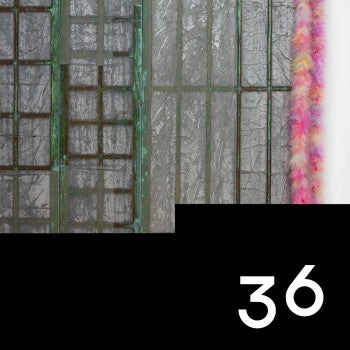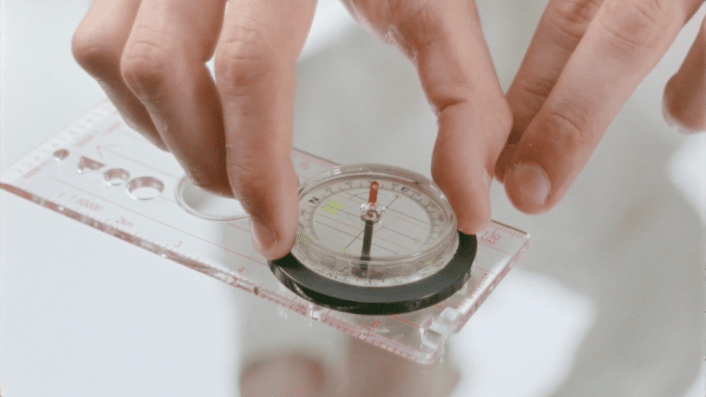
I see what you see
You are reading this in your browser. I don’t know what kind of device you are using, or which operating system, or which browser in particular (Chrome, Safari, Firefox etc.). But I can describe, with some confidence, a series of nested frames around these words: the TextWork title bar; the browser window, with its own title bar, tabs etc.; perhaps the edges of other programme windows or a desktop ‘behind’ the browser; the operating system menu bar, and perhaps a dock of applications; the rim of the device itself, a perimeter of metal, plastic or glass; and then, framing that, at the periphery of your perception – the world at large.
Here is my screen:
I am looking at an image of Laurent Montaron’s exhibition, Dioramas, at the Ricard Foundation in 2016-2017. To be precise, I am looking at a TIFF file in Preview. It is a large file (285 MB), in high resolution (11131 x 8536 pixels), which means I can zoom selectively and see tiny details of the exhibition space: what might be a pentagram on the cover of a book in a photograph half way into the space;
a cable tie for what look like fibre optic cables disappearing behind a ceiling panel;
the nails in the skirting of a partition wall;
the hollow end of a bamboo cane in the frame of a box kite.
If zoomed out, however, I cannot help but notice that perhaps 30% of the image is simply a white wall in the foreground, framing a rectangular window on the exhibition space. The exhibition photographer has skillfully adjusted the depth of field so that the glass in the window is barely visible – it can only be detected via some tiny reflections, for example a light fitting from the space behind the camera:
However, if you open another tab in your browser, go to www.instagram.com and search for #laurentmontaron, several of the first images which appear are amateur shots of the same view of the Ricard show in which the space on the photographer’s side of the glass appears more clearly. Sometimes we can see the photographer reflected:
At least one image appears to be from the opening of the show:
Why stage a contemporary art exhibition sealed behind glass?
The reason that most of the available images for Montaron’s show at Ricard, both official and otherwise, replicate an almost identical perspective is that the wall completely blocked off the exhibition space to the visitor: the window was the only point of access, and as a result the exhibition space itself was always empty. A second street entrance to the Ricard space took the visitor up a different stairwell, to the other end of the L-shaped space, but here they were presented with an equally self-contained display: a film, La réciprocité du récit (2016), also on its own in a sealed gallery space and only viewable from behind another ‘picture window’.
The show appeared to exist, in fact, precisely as the title promised: as a pair of dioramas. A whole reading of the show might spiral off from that title, from the peculiar history of the diorama as a display. It conjures, for one thing, the prehistory of photography: Louis Daguerre actually coined the term diorama – from the Greek ‘to see through’ – and was himself a diorama theatre impresario. The diorama has also long been regarded as part of the prehistory of cinema, a kind of vanishing mediator between theatre and film. We can trace a continuous, if eccentric, line which connects the nineteenth century aesthetic of the diorama – with all of its connotations of colonialism and the ‘natural history’ of empires, its echoes of panopticism – to early war photography and the evolution of operative images. But a diorama in the twenty-first century – as we might experience it in a natural history museum, for example – is a kind of living fossil, a monument to nineteenth century ways of seeing in the broadest sense1. This is not a thread I want to follow for now, except to ask: why stage a contemporary art exhibition sealed behind glass like a museal tableau?
What does it mean to carefully install a show full of potential relationships between two- and three-dimensional objects, and then to refuse the audience entry to it? Could it be, perhaps, a bizarre inversion of Michael Asher’s famous Claire S. Copley Gallery show in 1974, where Asher left the gallery empty and simply removed the wall separating the exhibition space from the office? Here, the gallery was plainly full of Montaron’s work and yet his new wall seemed to trap the audience on the office/foyer side of the divide.
The conceit would have become stranger if you had pressed yourself to the glass, and looked down at the floor immediately underneath the picture window. Here sat another work, Delay (2016): two Nagra reel-to-reel tape recorders connected by a single continuous tape loop, one recording the sound in the space and the other playing it, an endless audio palimpsest. Again, we might reach for a precedent from early conceptual art such as Christine Kozlov’s Information. No Theory (1970), a reel-to-reel recorder which endlessly recorded the sound of the gallery space but constantly overwrote its own recordings, without them ever being played. But in Kozlov’s case, the audience at least confronted the fact (or the promise) that the sounds they made were being recorded, even if they would never be heard: they could clap their hands in the gallery and imagine the sound inscribed, at least for a few seconds, onto the soundless loop. With Montaron’s twin tape decks, the promise was there – but the possibility of either being recorded or hearing it back was prevented by this wall. Delay, for all the viewer on the other side of the glass could tell, was simply recording and playing the sound of an empty space, inaudible inside its diorama.
Sitting in front of my screen, looking at the hi-res TIFF of the whole diorama, I am struck by a different detail however. If I zoom in on the work at the very back of the space, the large mirrored vitrine which the list of works tells me is called How can one hide from that which never sets? (2013), I see something reflected in it: a large black device mounted to the ceiling, otherwise out of sight around a corner but captured by the angle of the glass.
What is it? Could it be a video projector, perhaps projecting the film, La réciprocité du récit, which is visible from the second window? Or is it in fact part of the tail of the giant box kite, Train de cerfs-volants Saconney (2016), which snakes around the corner out of sight, and which I now read also includes a large format camera somewhere?
Suddenly I am scanning the rest of the image, maximising the magnification, looking for other reflective surfaces that might allow me to answer the question definitively – the opal sphere of the CCTV camera, for example:
But I have crossed the line from forensic examination into fantasy. I am inadvertently attempting a desktop remake of that scene in the original Blade Runner, when Harrison Ford’s character Deckard is able to navigate a digital photograph as if it were a three-dimensional space, seeing around a corner by amplifying the play of reflections:
Blade Runner (excerpt), 1982.
I did not see what you did not see
I never saw Dioramas in person. Everything I know about it comes from a mosaic of images, texts, conversations – as with the vast majority of the exhibitions which are currently taking place in the world and which I know mostly from my browser.
On my browser I have another tab open about another exhibition, which I did see in person: Artist’s Choice: Herzog & de Meuron, Perception Restrained, a collection exhibition at MoMA in New York in 2006, curated by the starchitect duo Jacques Herzog and Pierre de Meuron. Perception Restrained was a deeply peculiar, polemical exhibition – “perverse, cerebral and probably the most elaborate one-liner you’re likely to encounter this summer,” as Roberta Smith put it in the New York Times2. Herzog and de Meuron – who had lost the competition to design MoMA’s new building in the 1990s – put together a show of 110 objects from MoMA’s collection, together with dozens of films. The films were shown in a grid of monitors mounted in the ceiling, so you had to lie down to view them and it was almost impossible to focus on a single image. The objects, meanwhile, were assembled salon-style, squashed into small spaces – and only viewable through narrow slits in the wall. MoMA optimistically puffed the exhibition as hoping “to intensify the viewer experience, rendering it more memorable and personal than that of a conventional gallery setting.”3 But it seemed very clear that what Herzog and de Meuron wished to intensify was viewer frustration: to stage the inaccessibility of museum collections – both in the sense that so many works in a collection are unseen inventory for most of the time, and that even when they are on show it is as part of a spectacularised megamuseum experience which makes engagement almost impossible. The resulting exhibition was exasperating, bombastic and strangely thrilling.
Trying to put Montaron’s gesture in Dioramas in some context, I found the page for Perception Restrained on MoMA’s site and was pleased to see it came with a gallery of images. Above the images, however, was an interesting notice: “We used machine learning to identify some of the artworks pictured.” When clicking on the installation images, small purple circles appeared over some of the works – the ones, as it turned out, which the algorithms had been able to identify:
Automated picture recognition has developed exponentially in the last twenty years. In the 1980s, a British art historian called William Vaughan developed a pioneering tool called Morelli, which tried to compare images and look for resemblances – but constrained by the computing power of the day, it had to reduce every image to a grid of 1024 pixels (32 x 32).4 In 2018, Google’s ‘reverse image search’ can identify almost any image you upload to it and the web is being crawled by a billion bots, seeking both still and moving images from copyrighted databases. Only a fraction of the works in Perception Restrained seemed to have been successfully identified, however. Elsewhere on MoMA’s site, I found an explanation:
We learned that, like anyone, an algorithm has strengths and weaknesses. At present, the algorithm is very good at identifying static, two-dimensional images. Sculptures; moving image, installation, and sound works; and text-based artworks proved far more challenging. Unsurprisingly, multiples and editions of the same or very similar images also led to some “false positives.” Simply put, a machine can’t always tell one soup can from another. The algorithm may also incorrectly match photographs when the work on view was actually a different print of the same (or a very similar) image.5
The ‘machine learning’ in question, it turned out, had been developed by Google Arts & Culture Lab. Google, of course, is at the forefront of machine learning, or ‘AI’, and also image recognition technologies. Another part of their AI business had recently made the headlines, when some Google staff wrote an open letter protesting against the company’s contribution to the US Defence Department’s Project Maven, which appeared to include the development of AI tools for automatic recognition of objects recorded in military drone cameras.6
Toggling back to the image of Dioramas, I wonder how many of these works Google’s AI might have been able to identify. The kite which hangs so prominently in the centre of the room, for example, seems like precisely the kind of object the algorithms would struggle with – not least because it snakes out of sight around a corner. But this innocuous-seeming kite is, in fact, itself a reconstruction of a relic from the history of remote viewing. Montaron manufactured it based on a design of box kite developed by French army officer Jacques-Théodore Saconney in the early 1900s, to carry a camera for aerial surveying – in other words, it is a proto-drone. (Saconney is better remembered now for developing a man-lifting kite, also originally for military observation.)
Remote viewing has always been intimately connected to warfare, and Montaron has made other recent works in which he has painstakingly reconstructed military observation devices from the first world war: a hollow, steel-lined oak tree observation post and a telegraph pole concealing a periscope viewer (the latter hung horizontally on the gallery wall so viewers could try it for themselves). Both these works share a title, La réciprocité du récit (together with the film shown in Dioramas) – but what kind of reciprocity is involved here? The kite, the tree and the telegraph pole are connected by a kind of viewing which is not in the least reciprocal, at least on first site: they are prostheses for human vision, designed precisely to produce a situation of asymmetric information.
These works are peculiar in another way. They are, like the kite, careful and authentically-produced material replicas of no longer extant objects – Montaron himself has called them “readymades that disappeared”7. Making and exhibiting them in this way, Montaron cumulatively suggests a prehistory which points, via a peculiar trajectory, back to MoMA, Instagram and Google’s AI. Montaron’s objects conjure not just the evolution of remote viewing, but of what the filmmaker Harun Farocki incisively labelled ‘operative images’: “images that do not represent an object, but rather are part of an operation.”8 What Farocki suggested was that – even in the earliest photographic images taken from devices like Saconney’s reconnaissance kites and balloons – there was already a move away from images produced as the objects of a human act of looking and towards images as data, just another input in a cybernetic system which might eventually dispense with human vision altogether. The humanism of Blade Runner‘s fantasy is that Deckard’s discerning forensic eye is still needed to navigate the hidden dimensions of his digital image; Google’s dissenting employees sensed that they might be developing algorithms which would take human vision and judgment out of the loop altogether.
William Vaughan, developing his early art historical machine vision, already realised the implication that images “can be analysed and manipulated… in the same way as other forms of numeric data can be”.9 What Farocki perhaps did not fully appreciate, at least at the time he coined the idea of the ‘operative image’, is that all images might be on the same trajectory – those circulating on Instagram as much as the video feed from a self-guided missile. Because they are ultimately pure data, digital images are increasingly part of ‘operations’ by corporate and state algorithms, which we never see directly but whose effects we are only now starting to understand.
Montaron’s work – which is very different from Farocki’s in almost every other respect – seems to draw on some of the same aspirations to a form of media archaeology. One aspect of his Dioramas exhibition, as I contemplate it in this image, is a kind of highly-compressed set of allusions to the history of photographic present: the camera attached to the back of the kite; Montaron’s own large photographic prints; and finally the picture window itself and the title, which point back towards the diorama as a precursor to cinema.10
In Montaron’s work, what might strike us at first is the beguiling obsolescence of some of the technical devices, their frisson of Benjaminian anachronism. On closer inspection – which is to say, looking around and beyond what his works explicitly present – Montaron insists constantly on the continuity of these earlier modes of seeing with our own. These works insist on the shock of the old. They ask us to consider how much we are still governed by metaphors of vision which predate our technologies of seeing by centuries – just as the screen on which you are reading this on is a ‘window’.
The limits of images
Dioramas was a hermetic show, both in the sense of being sealed but also of being secretive; the antic provocation of restrained perception was balanced with a bass note of occult humour. If part of the play was with museal convention, it was equally a locked room mystery – as much Edgar Allan Poe as Michael Asher.


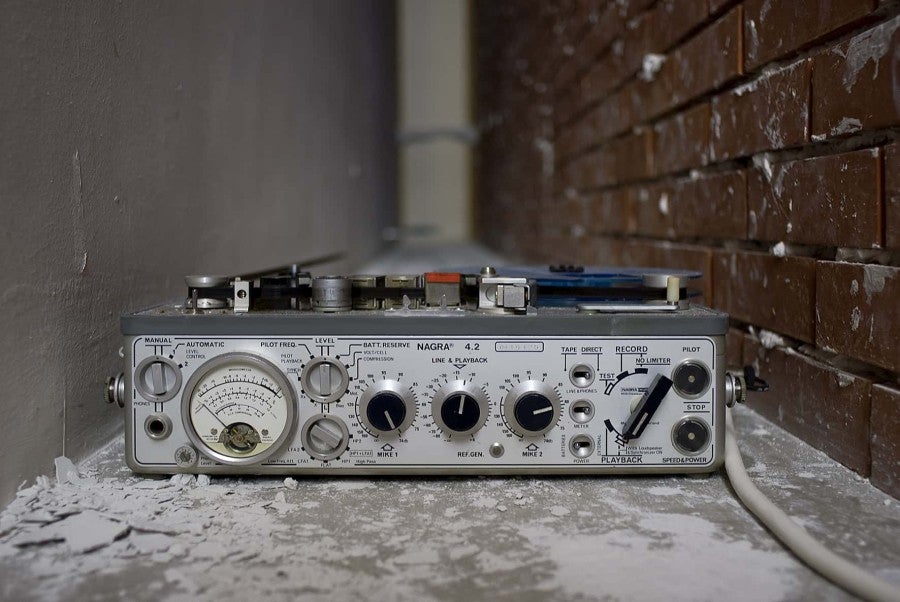
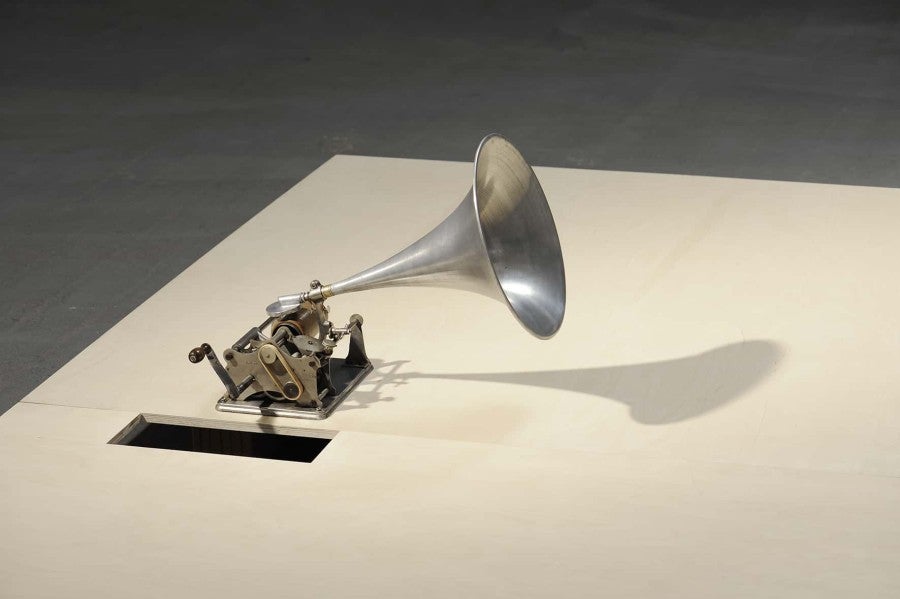
These works deliver their enigmas with a Sphinx-like smile...
Montaron’s work has long had a vein of cryptic, teasing reticence. An anvil sits flush on a piece of paper which we cannot read (Isn’t this what we like to believe rather than being left to the night?, 2010); an old Tape Echo device plays and records its loop inaudibly in a vitrine (Evans, 2017); a tape recorder built into a brick wall plays a message in Morse which, if deciphered, is discovered to be a command to ‘stop keying’ (Silent Key, 2009). Like Dioramas, these works deliver their enigmas with a Sphinx-like smile: we are left to decide whether there is, in fact, some secret content being withheld – or whether our own puzzlement, reflected back to us, is the secret.
At certain moments, Montaron’s work seems to go further and to ask very directly if the audience is required at all – or even to pit them directly against the work, as the agents of its disappearance or destruction. In Phoenix (2010), a wax cylinder recording of someone speaking in tongues is played through a gramophone, which is triggered when a viewer enters; every playing degrades the cylinder so the recording is gradually destroyed by its listeners. In one of his most recent works, Focus (2018), the entrance of a viewer becomes the trigger for the image to disappear: an analogue slide projector dims itself according to a proximity sensor, so that the audience only catches a flash of the image as they enter the space.
For all the apparently archaic technologies – wax cylinders, reel-to-reel players, slide projectors etc. – Montaron’s work seems to be sparring obliquely with a much more contemporary form of image-production. If in one sense his works’ self-sufficiency might be read as a parody of modernist claims for autonomy of the artwork, they seem more fundamentally to be offering playful resistance to the conspicuous consumption of digital images, especially of artworks. For some first generation conceptual artists, it was radically liberating to think that art might have an effect without our having any direct experience of it, merely as anecdote or rumour.11 The simple fact is that we now experience most artworks in mediated fashion, and there has been an increasing suspicion (voiced with varying degrees of cultural pessimism) that artworks are increasingly made with an Instagram or Snapchat viewer in mind.
Montaron’s allegiances are clearly, in part, to a tradition of conceptual art practice which has always questioned the ‘visual’ emphasis of the visual arts; but he seems also to be responding to a more general hypertrophy of the photographic. As ravishing as his work can be, and especially his photographs, the repeated gesture of tantalising withdrawal – the sense that the meaning of his works is constantly obscured in some way, inaudible, invisible – seems calculated to make us feel the limits of the photogenic. To put it another way, one of Montaron’s primary materials is our own anxiety, in its most inimitably millennial form: Fear of Missing Out.
This playful autoreflexive quality – using images to point to the limit of images – is one reason that Google’s algorithms might struggle to recognise Montaron’s works in a crowd. But it also points to another, understated technology among Montaron’s materials: writing. This might seem prosaic, but Montaron – again, drawing on a certain conceptual art genealogy – is hypersensitive to all of the extra-visual, institutional cues which condition our experience and understanding of artworks. Something like a list of works therefore becomes a material in its own right, a vehicle for ideas, and a more nuanced one than the advertorial blandishments of a press release.
The work How can one hide from that which never sets? consists of a wall-mounted vitrine, which contains a mirror. If we read Montaron’s material list, however, we get the following extraordinary litany:
Bois, verre, néon, Nitrate d’argent, AgNO3 , 0.10 M (solution de 21,6 g AgNO3 dans 1.2 L d’eau distillée), Hydroxyde de Sodium, NaOH, 0.80 M (solution de 26,4 g NaOH dans 0,60 L d’eau distillée), Glucose (dextrose), C6H12O6 , 0.25 M (solution de 5,1 g dans 0,125 L d’eau distillée), Ammoniaque, NH3 , concentration 30% (15 M).
This appears to be less a description than a recipe – which, in fact, it is. Montaron remade the peculiar mirror, which is semi-translucent, based on a process devised by Justus von Liebig in 1835 and which is credited as being the first modern mirror (as opposed to the predominance of polished metal surfaces which had served before that). This perplexingly specific itemisation italicises the decision to remake certain objects, in a way which clearly distinguishes Montaron’s interest from nostalgia (a patina of which might otherwise cling to some of his beautiful anachronisms). A list of materials becomes another material, a way to signpost that it is not some vague but evocative ‘past’ being evoked, but rather a historical object which paved the way to our very peculiar present. In the case of How can one hide from that which never sets?, the linguistic supplement transforms a seductive object into a monument to a moment in the history of self-regard – a precursor to the selfie.
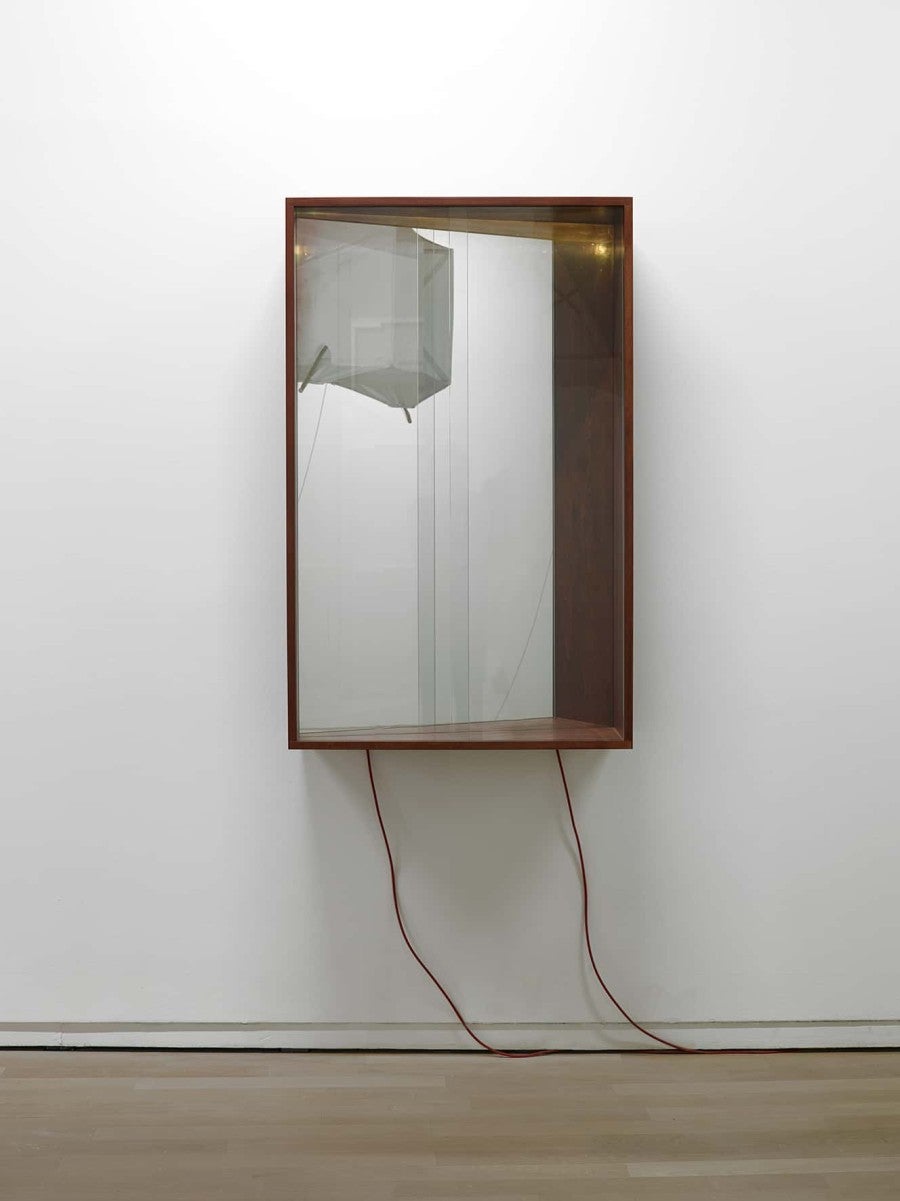
But the decision to list its ingredients also becomes a form of displacement, just as the angle of the mirror in the vitrine means the reflection is unexpectedly of another part of the room rather than our own. To discover the implications of this formula, or the story of von Liebig’s invention, we are going to have to search a little. Montaron’s gesture is a cheque cashed, in good faith, on our curiosity: in the era of much-rhetoricised ‘artistic research’, this list puts the onus on us to follow a thread and to continue our experience of this work beyond what we can immediately see or read in any given exhibition. I am reminded of what Richard Kerridge recently wrote of the poet J.H. Prynne’s work, which is notoriously full of fragments of technical languages and rebarbative jargon:
Obstruction of this kind foils the instant and unreflective gratifications associated with heedless consumerism… Prynne’s work demands a reader who is willing not only to defer the gratification of the complete (or at least provisionally complete) reading experience in one sitting, but also to allow the longer process of interruption and resumption to take up a larger and more dispersed part of their lives.12
Montaron’s work seems to pursue a similar utopia: by erecting some barriers – shutting us out of certain immediate forms of relationship to the work, keeping us at bay – it challenges us to dissolve others: to take on the experience of the work beyond the bounds of the gallery and our ‘feeds’ into a deeper but more dispersed form of engagement, where the limits have not been legislated in advance.
The limits of logic
If you had begun your experience of Dioramas by entering the ‘second’ staircase at Ricard and discovering the film, La réciprocité du récit, you would have encountered a somewhat different, more dreamlike aspect to Montaron’s work. These occult qualities I have been discussing – of opacity, self-concealment, displacement, underwriting by language etc. – are ultimately facets of Montaron’s ludic pleasure in paradox. The other face of this playful elusiveness is a more innocent form of magic, a kind of childlike delight in illusion. It is as if Montaron had burrowed a secret art historical passageway to connect the political-media aesthetics of peers such as Christopher Williams, say, or Gerard Byrne, with the Jean Cocteau of Orphée.
La réciprocité du récit is a kind of anthology film, incorporating and interleaving several of Montaron’s other short films (Memory and The Philosopher’s Stone, both 2016). Various threads are intertwined: a woman’s voiceover tells a dreamlike narrative about a rowing boat; a woman on-screen takes a bath, records a phone call on a reel-to-reel; a gold coin is seemingly melted down and then recast, good as new; a box kite bobs in the wind; an early IBM Memory, the earliest digital typewriter, seems to write for itself in a cobwebbed attic… In one striking sequence, a man’s voice over the radio gives instructions on how to restart a stopped watch using the power of the mind; based on Montaron’s own memory of hearing a Uri Geller radio ‘experiment’. It is a reminder that the promise of genuinally reciprocal mass media still seemed like a political utopia (think Brecht’s writing on radio) or sheer magic only a couple of decades ago.
The connections between these disparate elements are never explicit, but the images – shot on 16mm film – are luminous and hypnotic. The soundtrack, especially the voiceover, also gives us a sense of a single continuum, holding the sequences together in a dreamlike constellation. Is the main narrator’s voice that of the woman who appears on-screen? She speaks in a calm, slightly absent way, even when she is recalling the sensation of drowning; she seems as detached from the ‘I’ of the story she is telling as from the images on screen. The language remains simple and matter of fact, even when the experiences being described are paradoxical (“The boat was floating upside down under the water… I tried to sink to find the surface…”).
The film contains various kinds of loop – the cycle of the gold Napoléon, for example, which (via the power of editing) is apparently melted and reminted. And this vein of conjuring continues too: the water drops which fly upwards to the woman’s face; the hand which seems, Uri Geller-style, to turn the needle of a compass. Or there is the typewriter writing to itself, producing this soliloquy:
It is true that I do not speak
and it is false to say
that I wrote this sentence.
But just as one speaks
without knowing how the single sounds are produced,
I possess the capacity of constructing languages,
in which every sense can be expressed,
without having an idea how and what each word means.
Neither am I you or I.
Here we are again in a kind of loop, this time of logic. Who is speaking here? We seem to be close to the poet Novalis’ short prose-poem Soliloquy from 1798, in which the speaker begins with the assertion that language “is only concerned with itself” and so, “if one wants to speak about something specific, capricious language makes one say the most ridiculous and mixed up things”. Novalis’ speaker is led into treacherous territory, however, when she has to acknowledge that she herself has wanted to speak about this capriciousness of language, and that therefore “because I have wanted to say it, I have said something completely ridiculous”. But there is one more twist, in which intention and language might yet be made to coincide: “what if I had to speak, and this drive to speak were a marker for the inspiration, the effectivity of language in me? And suppose my will only wanted that which I had to do?”13 Could this be the true ‘reciprocity of the story’: that our languages – not only verbal, but also visual: aerial photography, art exhibitions, Instagram Stories – determine who we are, in ways too radically fundamental for us to ever fully appreciate? In other words, that at some point the story tells us?
The typewriter’s soliloquy also echoes another of Montaron’s works, Revision Theory of Truth (2016): a series of photographs in which a man is seated at a lightbox drawing a stencilled text. In one iteration the text reads:
1 is true
1 is not true is true
if and only if 1 is not true
Another appears almost identical, except that the man’s hand is in a slightly different position and the text reads:
1 is not true
1 is not true is true
if and only if 1 is not true
These sentences send us round a moebius strip of thought, after the model of the famous liar’s paradox: if I declare that I am lying, am I telling the truth? One of the most fascinating discussions of this paradox came when Ludwig Wittgenstein’s wartime Cambridge lectures on the foundations of mathematics were attended by a young Alan Turing. Wittgenstein and Turing, now famous as the founder of modern computing, ended up in a series of stand-offs over the status of mathematical and logical problems, including the liar’s paradox.14 For Wittgenstein, “it is just a useless game, why should anyone be excited… where will the harm come?” For Turing, this was anathema:
Turing: The real harm will not come in unless there is an application, in which a bridge may fall down or something of that sort. You cannot be confident about applying your calculus until you know that there are no hidden contradictions in it.
Wittgenstein: There seems to me an enormous mistake there. … Suppose I convince [someone] of the paradox of the Liar, and he says, ‘I lie, therefore I do not lie, therefore I lie and I do not lie, therefore we have a contradiction, therefore 2×2 = 369.’ Well, we should not call this ‘multiplication,’ that is all…
Turing: Although you do not know that the bridge will fall if there are no contradictions, yet it is almost certain that if there are contradictions it will go wrong somewhere.
Wittgenstein: But nothing has ever gone wrong that way yet…15
Montaron’s art is, in one sense, a wager on Wittgenstein’s ‘yet’. His works hold open a space for performative contradiction, for those forms of experience which are, literally, incalculable. These include not simply the oneiric forces which nourished surrealism, but also the forms of rationalism which would cherish, rather than seek to dissolve, the liar’s paradox – the philosophical tradition of Heraclitus, for whom change alone was unchanging.
The space produced by Montaron’s work is really a kind of fissure, a crack in a logic of image-production and circulation which tends to resolve everything – art included – into the operative. The ever-expanding realm of the operative is ultimately that of what Turing calls ‘application’ and concerns not only what keeps the bridge standing, but also – depending on where in the world you build it – the algorithms of a self-guided missile which collapses it. Against the narrowness of such instrumental reason, Montaron offers, in the words of one of his works, an ‘invisible message’. His works focus on the flux of the river underneath, into which – as Heraclitus famously averred – we can never step twice.
See Donna Haraway’s account in ‘Teddy Bear Patriarchy: Taxidermy in the Garden of Eden, New York City, 1908- 1936’, in Primate Visions: Gender, Race, and Nature in the World of Modern Science, London and New York, Routledge, 1989.
Roberta Smith, ‘Once Again, Herzog & de Meuron Offer Their Vision of the MoMA’, 30 June 2006: https://www.nytimes.com/2006/06/30/arts/design/30cura.html.
William Vaughan, ‘Automated Picture Referencing: A Further look at 'Morelli', Computers and the History of Art, Vol. 2, No. 2 (1992), p. 7-18.
See ‘‘The Business of War’: Google Employees Protest Work for the Pentagon’, https://www.nytimes.com/2018/04/04/technology/google-letter-ceo-pentagon-project.html. The text of the Google employee’s letter is at https://static01.nyt.com/files/2018/technology/googleletter.pdf.
In conversation with the artist, February 2018.
Harun Farocki, ‘Phantom Images’, Public, 29 (2004), pp.12-22, 17.
Vaughan, p.16.
Perhaps the most famous and influential set of dioramas, those of the Natural History Museum in New York, were designed by the less well known Carl Akeley, a pioneering taxidermist who also patented a cinecamera in 1915; he optimised it for capturing wildlife, but it was soon adopted for aerial photography – including aerial reconnaissance; the Akeley camera even became the official camera of the U.S. Signal Corps for a time.
See, for example, British conceptual artist Keith Arnatt’s discussion of his relationship to Claes Oldenburg’s Placid Civic Monument. Oldenburg’s work involved gravediggers digging a hole in Central Park and filling it in again, something which Arnatt had only read about: “The first question that arises is, did he do it? And what difference would it have made if he didn’t do it? That was really the most thought provoking thing for me at that time...”, Conception. Conceptual Documents 1968 to 1972, Norwich Gallery, Norwich, 2001, p.110.
J.H. Prynne, The Oval Window: A new annotated edition, ed. N.H. Reeve & Richard Kerridge, London: Bloodaxe, 2018, p.18-19.
Novalis, ‘Soliloquy’, in Theory as Practice: A Critical Anthology of Early German Romantic Writings, ed. and trans. Jochen Schulte-Sasse et al, Minneapolis: University of Minnesota Press, 1997, p.145-6.
For an unusual discussion of their impasse, which takes as its starting point both thinkers’ vexed sexuality, see Jacob Gaboury, ‘A Queer History of Computing – Part 2’: http://rhizome.org/editorial/2013/mar/19/queer-computing-2.
Ludwig Wittgenstein, Wittgenstein's Lectures on the Foundations of Mathematics, Cambridge, 1939, ed. Cora Diamond, Chicago: University of Chicago, 2015, p.217-8.
